Just the name of the city of Lucknow evokes a sense of an era of understated elegance and refinement, of art and poetry and romance. Something that I miss in these times of over-the-top loud posturing and crass promotions all around. However, we recently found a precious gem in ‘Chaasmi’ by Nandiniy Singh of Lucknow at the recent pop-up “A Royal Indian Summer” organised by Anshu Khanna’s Royal Fables at The Chanakya in Delhi. Nandiniy brings alive the essence of Lucknow, of Awadh, her understanding of poetry, her regional heritage, a culture that she seemingly effortlessly imbues into her label ‘Chaasmi’. In a candid Q&A exclusively for The Luxury Chronicle, Nandiniy Singh tells us more about ‘Chaasmi’.
 When did you launch Chaasmi? What does the name mean?
When did you launch Chaasmi? What does the name mean?
Chaasmi was born in the pandemic, at a time when my thoughts needed form and the karigars a livelihood, so out of work and struggling to even make ends meet. The one big advantage that we had on our side was time, which allowed us to do, re-do, till we reached that perfect stitch. We worked in the outdoors, crafting and creating, intricately embroidered saris, drawing from the perfect vibe of nature, under the warmth of the winter sun.
Chaasmi is Sanskrit for ‘As I am’.
Your logo for Chaasmi is a bird in flight. Why a crane? What is the significance?|
 The identity of a ‘Crane in Flight’, suggests free spiritedness and the spreading of wings, as one soars high, much like the women we want to allure to our collection. Our purpose is to create unique masterpieces which will make women feel their inner strength as they embrace their feminine best, unapologetically.
The identity of a ‘Crane in Flight’, suggests free spiritedness and the spreading of wings, as one soars high, much like the women we want to allure to our collection. Our purpose is to create unique masterpieces which will make women feel their inner strength as they embrace their feminine best, unapologetically.
What is the USP of Chaasmi?

Green Saree from our Ritu-Samhara (Pageant of Seasons) Collection
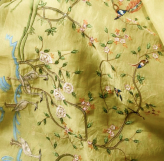 We believe in fluid synthesis of craft and fashion in creating timeless pieces. Our USP is fusion of different styles of Craft. Like this Green Saree from our Ritu-Samhara (Pageant of Seasons) Collection has a scene from the month of Saavan (Indian Monsoon) when nature is in full bloom and the air is ripe with pleasant, dewy petrichor of the post rain morning, melody of the birds, complete with lakes filled with water, leaves – some fresh, some wilting, as old gives way to new. Embroidery is combined with hand painting to create this saree. Thus, every piece we create tells us a story of rich Indian heritage, they are inspired by the Sanskrit classics, travels and Nature. In short, a story told by the traditional arts of Avadh.
We believe in fluid synthesis of craft and fashion in creating timeless pieces. Our USP is fusion of different styles of Craft. Like this Green Saree from our Ritu-Samhara (Pageant of Seasons) Collection has a scene from the month of Saavan (Indian Monsoon) when nature is in full bloom and the air is ripe with pleasant, dewy petrichor of the post rain morning, melody of the birds, complete with lakes filled with water, leaves – some fresh, some wilting, as old gives way to new. Embroidery is combined with hand painting to create this saree. Thus, every piece we create tells us a story of rich Indian heritage, they are inspired by the Sanskrit classics, travels and Nature. In short, a story told by the traditional arts of Avadh.
What are the kinds of embroideries and embellishments on the sari?
We use traditional embroideries like Zari Zardozi, Aari, Jaali, Pitta work, Mukaish, Parsi Gara, Crewel Stitch, French Knots, Hand painted, Sequins, Pharesha, Beads work in our creations.

Aari Work
Zari Zardozi is one of the most luxurious form of traditional embroidery. Aari work is a type of embroidery with a pen like crochet needle, on fabric stretched tightly over a wooden frame. Aari artwork is popular for its fine and delicate thread work. Mukaish an almost dying craft of Lucknow, is age-old metallic embroidery with thin strips of metallic wire. Jaali work is a lattice like delicate embroidery and material in the lattice is carefully snipped from behind. Unlike in Cutwork embroidery technique where small portions of the fabric are first cut out and the raw edges are completely covered with stitches. Pitta work is an ancient embroidery craft, wherein the filling is first done with the help of metal wires and then it is beaten so that the texture becomes uniform.
Faresha is an embroidery technique widely used in Avadh. Parsi Gara, French Knots, Crewel Stitch and Satin Stitch are used extensively with small motifs of birds and flowers running in a 9 metre border.
How long does it take to embellish a sari like this?
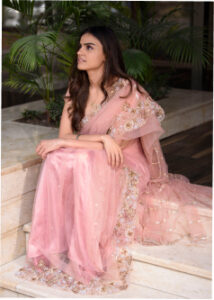
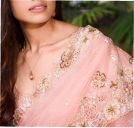
A saree like this, which is a combination of Sequins, Zardozi, Aari, using beads and other embellishments with different shades of Copper, Silver and Gold zari threads and Kora will take a Month for completion.
What is the preferred fabric for a heavily embroidered sari?
 We use Silk, De chines, Georgette, Banaras tissue and Chanderi tissue for very heavy embroidery. But contrary to the popular belief Organza’s and Chiffon’s too can hold embroidery very well and impart a very soft, delicate feminine feel to our creation.
We use Silk, De chines, Georgette, Banaras tissue and Chanderi tissue for very heavy embroidery. But contrary to the popular belief Organza’s and Chiffon’s too can hold embroidery very well and impart a very soft, delicate feminine feel to our creation.
 Is there a special process for sourcing the fabrics for the Chaasmi Saris?
Is there a special process for sourcing the fabrics for the Chaasmi Saris?
We do not compromise on the material and get it from the original source of each of these materials, Therefore a trip to Surat, Chanderi, Varanasi and Bangalore became a necessity. After much deliberation and research we outsource from these cities. Straight from the manufacturer and looms. Sometimes even order our special combination of taana-baana as our customer deserves only the finest embroidery and material.
Lucknow is renowned for its Mukaish and Chikankari embroidery. How do you keep the old looks trendy and fresh?

 We keep traditional look fresh and trendy by selecting a fresher colour palette which was referred to as ‘English colours’ by our mothers and by combining different artforms. Hand painted plus thread work depicting a scenery symbolising the month of saawan. Mukaish with thread work and cutwork done in Turkish style. Zardozi, Pitta-work and French knots used together in English style roses with traditional border. Or sometimes Pitta work, jaali, zardozi, sequins are all put together. Thus using more traditional styles in more contemporary way.
We keep traditional look fresh and trendy by selecting a fresher colour palette which was referred to as ‘English colours’ by our mothers and by combining different artforms. Hand painted plus thread work depicting a scenery symbolising the month of saawan. Mukaish with thread work and cutwork done in Turkish style. Zardozi, Pitta-work and French knots used together in English style roses with traditional border. Or sometimes Pitta work, jaali, zardozi, sequins are all put together. Thus using more traditional styles in more contemporary way.
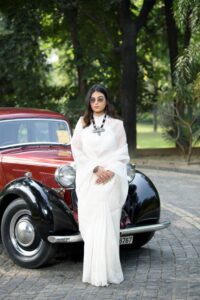
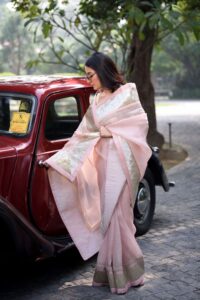
Are you open to customization requests from clients?
Yes, we do customise requests as per colour and material.
Do you also restore antique saris? Has such a project come to you?
We do restore antique saris by transferring the work on a new material. Yes, we have done such projects.
Is Chaasmi only about saris or do you also have other stitched women’s/men’s apparel like jackets, suits, kurtas, achkans etc? If not, do you plan to add that to your repertoire?
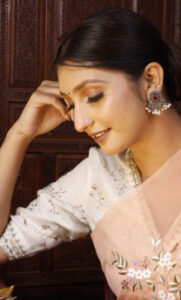
Blouse & Sari
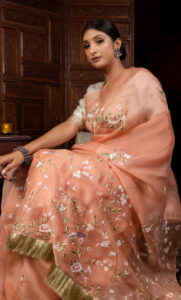
Sari
Chaasmi not only does sarees but also blouses, dupattas, lehngas. We are in the process of creating shawls, stoles, Nehru jackets for our winter collection. Soon we will be incorporating Achkans too.
Which is the most flamboyant sari that you have created?
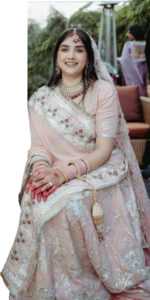

The most flamboyant piece created by us is the lehnga. The peach moonga silk lehnga has an amalgamation of pitta work in soft gold and silver couple with jaalis and a spread of zardozi to high light the design. With an edging of silver mukaish. The dupatta has a border of English roses in antique gold and silver zardozi with French knots in pink and magenta and simultaneously a narrow silver and gold pitta work border on both sides. The ensemble was completed with a silver gota on the flipside of the embroidery to conceal cut threads.
Check out Chaasmi’s Instagram page.
https://instagram.com/chaasmiofficial?igshid=ZDdkNTZiNTM=

1 comment
Excellent article on Chaasmi